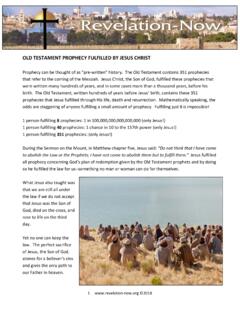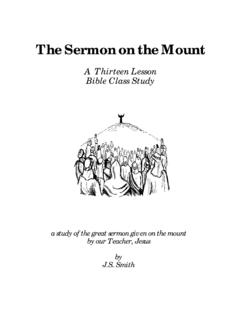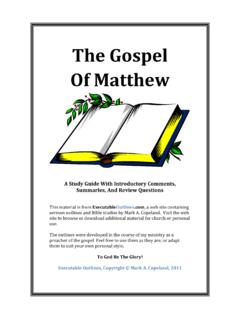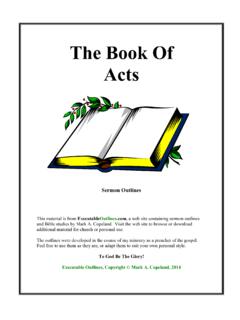Transcription of Come Follow Me Sermon Series - South Carolina United ...
1 Come, Follow Me Come, Follow Me: A Disciple's Journey Through Lent Introduction to the Sermon Series Several years ago, a group of clergy in the South Carolina Annual Conference attended a continuing education event at Lake Junaluska. They came away with one question: How can we help people begin to move from thinking of themselves as church members and to identifying themselves as disciples of Christ? That question became the basis for Come, Follow Me, a Sermon and study Series published by the South Carolina Conference in 2018. That study followed discipleship growth in the apostle Peter. Now comes another Series for use during the season of Lent. Before looking at the Series , I invite you to consider the foundational question concerning the movement from membership to discipleship. The question raised at Lake Junaluska was not a solitary one. Other church leaders have wrestled with similar questions and written books concerning the movement from member to disciple.
2 Some examples: Deepening Your Effectiveness, by Dan Glover and Claudia Lavy Twelve Dynamic Shifts for Transforming Your Church, by Stanley Ott Shift, by Mark Tidsworth What is the concern and why? At its simplest, if we identify ourselves as members of the church, we are free to come and go at will the condition of many contemporary civic and service organizations. If we identify ourselves as Christian disciples, everything we do falls under the authority and power of Christ. We live our commitment to Christ through the church and through all our actions. Our lives are less about going to church and more about being the church. Our commitment to Christ becomes our commission to Follow Jesus and to serve in the work of Jesus. Come, Follow Me: A Disciple's Journey Through Lent looks at defining moments in Jesus' ministry as presented in the Gospel of Matthew. The five sermons are: Sermon 1: The Baptism of Jesus (Matthew 3:13-17) Jesus sought baptism from John.
3 What does it mean for us to be baptized into Christ? Sermon 2: Wilderness and Temptations of Jesus (Matthew 4:1-11) Following the baptism, Jesus went into the wilderness. There he experienced severe temptation concerning his identity. What are the challenges to our identity as Christian followers? How do we face such temptation? 2. A Disciple's Journey Through Lent Sermon 3: The Beatitudes, Salt and Light (Matthew 5:1-16) A crowd gathered to hear Jesus, who gave them a basic understanding of life within God's kingdom . How are we embracing and living these values of God's kingdom ? Sermon 4: Prayer and Attitude (Matthew 6:1-18) Jesus continues to teach about the kingdom of God and different facets of discipleship. How are we engaged in the work of introspection, prayer, and fasting? Sermon 5: Healing, Exorcism, Service, Following (Matthew 8:14-27) Jesus and his disciples engage in hands-on ministry.
4 What is our ministry? How are we following Christ in ministry and mission? We did not include a Sermon for Palm/Passion Sunday, the sixth Sunday in Lent, because of the many different congregational traditions on this day. Know that your church's traditions will also guide the formation of disciples. Each chapter of this Series includes these features (and a few more): Note to the Pastor Some pastoral background Exegesis A light introduction (you will do more digging). Sermon Outline The big ideas of the Sermon Sermon That which was preached Other Illustrations For use within contemporary and traditional setting Hymn and Song Suggestions Traditional and contemporary suggestions Bibliography A working list of resources In addition to the Sermon Series , a separate Leader's Guide is available with suggestions for small groups. Each session in the Leader's Guide include recommendations to help group participants or the entire congregation grow spiritually through different spiritual disciplines.
5 We hope that the conversation about discipleship will guide all as we partner with God for the transformation of the world. For the working group, The Rev. George Donigian Rev. Donigian is an ordained elder in the South Carolina Conference. He is the pastor of Shiloh United Methodist Church in Piedmont. 3. Come, Follow Me Sermon 1: The Baptism of Jesus Writer: Rev. Dr. Laura Canine Scripture: Matthew 3:13-17. Note to the Pastor: We will join with Christ in his baptism in the Jordan River an event so significant that it finds its way into all four gospels. 1 We will see and hear the presence of the Holy Spirit and God's declaration that he is well pleased with his son. A common question that generally comes along with this Scripture: Why was Jesus baptized if he was without sin? Jesus explains that he needs to fulfill all righteousness 2 and does so in complete obedience to God's plan. In doing so, Jesus simultaneously affirms John's ministry and is able to identify with the people that he came to save.
6 John baptized as part of a call to repentance and to encourage a complacent and even defiant nation to turn back to the God they had abandoned but he also told his followers that Jesus would baptize with the Holy Spirit, enlivening God's power within them. In the Great Commission that he offers his disciples just before he ascends to heaven, Jesus again makes baptism an integral part of the mission to make disciples, telling them (and us) to go and make disciples of all nations, baptizing them in the name of the Father and of the Son and of the Holy Spirit. 3. Having just walked through the penitential nature of Ash Wednesday, this is a most appropriate season to consider that our baptism (and baptismal remembrance) is an intentional dying to sin. To consider that out of that death comes new life and a new identity as those saved by on overflowing measure of God's grace. We will take time to reflect on our own baptisms as a pivotal point in our journey of salvation.
7 As we know, the sacrament of baptism occupies a distinctive place in our faith and plays a vital role in the life of the church. This visible sign of an invisible working of grace brings us to salvation and launches us on the road of holiness both personal and social. So, what exactly does it mean for us to be baptized into Christ? Because God works in and through baptism to connect us to the beauty of his transforming love in Jesus Christ, how does our day-to-day living change as a result? Exegesis: Matthew 3:13-17. The name Matthew in Greek (Maththaios or Matthaios) is abbreviated from the Aramaic word meaning gift of Yahweh and occurs in the four lists of the Apostles (Matthew 10:3; Mark 3:18; Luke 6:15; Acts 1:13). 4 The author of this Gospel traditionally has been accepted as Levi, the tax collector of Capernaum, who was called by Jesus to Follow him (Matthew 9:9; 10:3). 5 Some commentators note 1.
8 Matthew 3:13-17, Mark 1:1-13, Luke 3:21-22, John 1:29-32. 2. Matthew 3:16. 3. Matthew 28:19. 4. Clifton J. Allen, ed., The Broadman Bible Commentary, (Nashville: Broadman Press, 1969), 72. 5. W. Sunderland Lewis and Henry M. Booth, The Preacher's Homiletic Commentary, (Grand Rapids: Baker Book House, 1974), 1. 4. A Disciple's Journey Through Lent that while Mark and Luke seem to distinguish between Matthew and Levi as two separate individuals, the Gospel of Matthew seems to present them as the same figure. 6 The Church Fathers grant that his status as a disciple of Christ would have allowed him direct knowledge as an eyewitness to most of the events of Jesus' earthly ministry. Regardless of the speculation of the author's identity, Matthew is more than a historian, more than a writer, more than an author, more than an editor or a scribe. Matthew can be more accurately described as an evangelist. 7 As one who has been through a transformational conversion and received a new identity, he writes to all who will listen/read about serving the one who rescued him.
9 Matthew's audience seems to comprise Jewish Christians who would undoubtedly be familiar with Matthew's explicit connections to Old Testament prophecy . They also would have knowledge of covenant language since God already had constituted a servant community of the people of Israel . promising to be their God and giving them the Law to make clear how they were to live. Matthew builds on that prior knowledge to offer that ultimately, in the death and resurrection of Jesus Christ, God fulfilled the prophecy of a new covenant (the sign of which is baptism rather than circumcision) 8. and called forth the church as a servant community. 9 Such a covenant is sealed with those who believe in the saving work of Jesus Christ and declared in baptism with a corresponding commitment of faith. 10 Baptism in itself would not have been a foreign concept as it is similar to purification rituals of Judaism, but Matthew will portray throughout his Gospel that the Christian's baptism represents the spiritually invisible sign of cleansing and forgiveness while analogous to Christ's death, burial and resurrection.
10 11. While not a formal biography or historiography, Matthew has painstakingly organized a recollection of familiar accounts based on first-hand knowledge or the careful transmission of such knowledge. Because Matthew's purpose is to familiarize readers with Jesus as the prophesied Messiah, the author includes records of Jesus' teaching and healing, as well as genealogy, as evidence. The Jewish Christians to whom Matthew writes may be characterized heavily by their faithfulness to Scriptural law and their general familiarity with the Scriptures themselves. By accepting the Good News of Jesus Christ, this community would embrace Jesus to be God's promise to Israel as the fulfillment of the law of the prophets. Central themes prevalent in Matthew include: The fulfillment of the prophets' words involving Jesus as God's promise of salvation. The identity of Jesus as servant/Messiah/Lord. The inclusion of Gentiles in God's kingdom .













